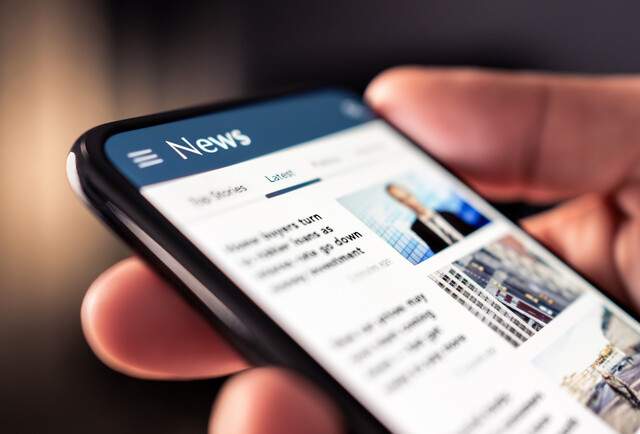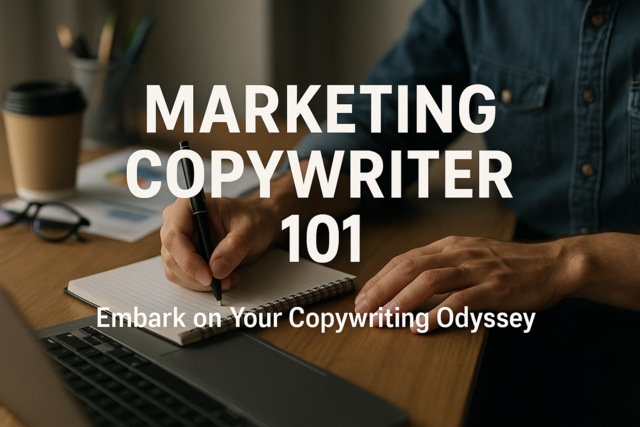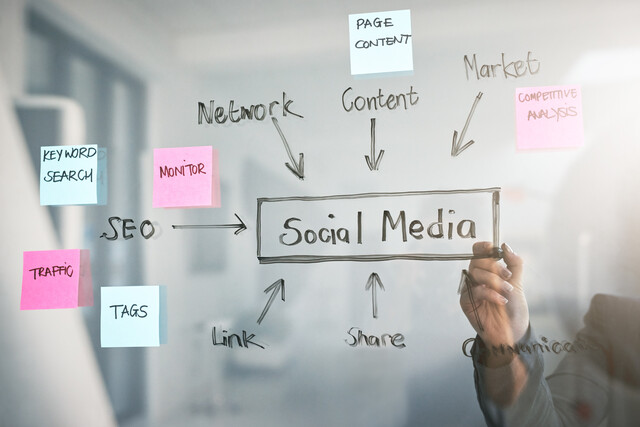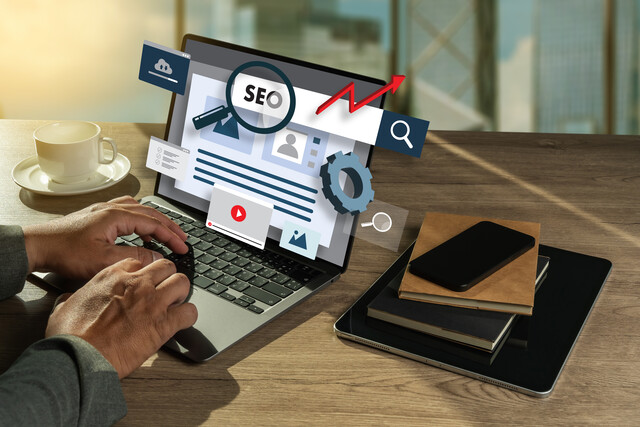Printed marketing collateral refers to marketing pieces printed by a commercial printer, then distributed to consumers and customers to share a brand's story and build brand awareness. It does not include advertisements or direct mail pieces whose purpose is to generate leads and make sales.
Printed marketing collateral can be sent to consumers and customers via physical mail. It can be presented to customers at trade shows or at the customer's physical location. It can also be displayed on posters or even on billboards.
Take a minute to think of billboards that have caught your eye recently, and recall the marketing message on the billboard. The brand is prominent in a billboard display, as is the USP or another value-oriented message or tagline. A billboard never asks for a sale. It gives consumers and customers a little information, then a step to take to learn more, such as a phone number.
Listed below are some examples of printed marketing collateral.
? Business cards
? Press releases
? Brochures
? Postcards
? Flyers
? Letterhead
Terms to Know
Locate the terms below in the dictionary, then fill in the meaning of each word in your "Student Dictionary" by using Google or another search engine to find the definition.
1. Direct mail
2. Press release
3. Inverted pyramid method
Writing Copy for Postcards
While postcards are not the most effective way to advertise and generate sales, they are great tools for building brand awareness and generate interest. As with any piece of marketing collateral that you create, you should include compelling copy, as well as a call to action. The call to action on a postcard can be a phone number to call or a website to visit.
When writing postcard copy:
1. Keep in mind that you have limited space. Keep the copy down to one main idea, and make the copy compelling.
2. Include as much information as you can on the postcard without making it too cluttered and hard to read.
3. If you use a graphic on the postcard, make sure the graphic relates to the message delivered in the copy. In any piece of marketing collateral, the graphics or images used should match the message and be used as a tool to generate curiosity about the message. Do not try to grab attention with a cute or shocking visual if it does not match the headline or copy.
Writing Copy for Brochures
Brochures are effective tools for educating consumers and customers about a brand or product. While brochures can be used to generate leads and create sales inquiries, they can also simply be used to build brand awareness. Chances are, you have seen brochures created to build brand awareness or to educate you about products or services at doctors' offices, insurance and realtor offices, et cetera. They are usually placed in cardboard displays or racks where they are easily seen by customers.
The most common type of brochure you will see is a tri-fold brochure, meaning it is folded three times. The type of copy you will write for a brochure will strongly resemble website copy. Your goal is to provide the information intended for the brochure in a compelling way that grabs attention and makes the customer want to read - and keep reading. While you will use a headline for the front of your brochure, you want to use subheads to break the brochure copy into sections to make it easy for someone to find what they are looking for - and to make it easier to read.
Let's look at some rules to creating and writing copy for brochures that improve their effectiveness.
? The front cover of a brochure is not just a place for a pretty picture and the name of the company. Use a headline that will compel your reader to want to read more. Brochures are excellent for using a "reason why" headline.
? When writing copy for a brochure, you want to think about the customer, not the brand or product. What problem does the customer face that your brand or product will solve?
? Write strong end-of-page copy. When you get to the end of a page in a brochure, you want to write copy that will make them want to go to the next page.
? Remember to write about benefits. How will those benefits help the customer?
? If you need to include technical information in the brochure, place it in a chart or graph. Do not put it in the copy.
? Use visuals to establish credibility. Use engaging language that answers customers' questions.
Writing Copy for Flyers
A flyer is a type of marketing collateral that just consists of one sheet of paper, unfolded, and usually 8.5" x 11". A flyer contains a headline that states the main benefit the consumer or customer will get from reading the copy. It also contains copy that is typically used to get the client to take action and call a number or visit a website.
Here are some other tips for writing flyer copy:
? Use white space around different elements of the copy. It makes it easier to read.
? Use bulleted lists. Bulleted lists grab attention when used on flyers. Using lists also creates more white space. Use bulleted lists to state benefits. However, remember to write to the consumer or customer - and not about the company. Write how the benefits solve the consumer or customer's problem or relate to their situation.
? Make sure to focus on benefits, not features.
? Do not get too fancy with different fonts and a lot of graphics. Only use two different types of font - at the most. Sans-serif is a good font to use for the headline. Only use one or two images. If you use more, it can make the flyer seem cluttered.
? Include a strong call to action.
How to Write and Format Press Releases
A press release is an official announcement that a business writes, then distributes to the media, typically using a press release distribution service. Press releases can also be known as press statements, news releases, or media releases.
They can be used to announce:
? When someone in a company receives an award
? When a company opens a new office
? When a company re-brands
? When a company wants to introduce a new partnership
? When a new product is launched
? When a company hires or promotes an executive
Press releases are written using the same style as news articles written by journalists. That is to say that they are written using the inverted pyramid method with all important information in the first paragraph.
Let's take a look at the anatomy of an effective press release.
? Logo. The company's logo goes at the top of the press release page and should be centered on the page. Include a high resolution copy of the logo if you are emailing the press release.
? Contact information. Contact information should go below the logo and be aligned the left side of the page. It should look like this:
Contact: First and last name
Tel: Telephone number
Cell Phone: Cell phone number
Email: email address of contact
Website: Company website
? Release Date. The release date appears on the same line as the first line of contact information, but is aligned to the right side of the page.
? Dateline. The dateline appears on the first line of the first paragraph of the release. It comes at the beginning of the paragraph and looks like this: "MIAMI, FL September 8 - ". A dash separates the dateline from beginning of the first paragraph.
? The headline. The headline needs to be captivating in order to inspire people to read the press release. Use action verbs, but keep it simple and short.
? The first paragraph should give the reader all the information and facts they need. It should include the who, what, why, where, and how.
? Subsequent paragraphs. In the paragraphs that follow, support the information in the first paragraph. Use quotes from stakeholders, executives, or anyone within the company who can help state how the news in your press release either affects the industry or its customers. Any quote you use should shape and emphasize the importance of the news you are sharing. Why is this news so important? How does it affect the industry and the customers? What does it mean for the future?
? Last paragraph. The last paragraph contains information about the company, such as when it was founded, awards it has received, and its mission. Do not include more information on the reason for the press release. While it may be tempting to write a conclusion or to summarize the release, do not.
Marketing trends occur when the marketing behavior of a business proves to be an effective and profitable way of connecting with consumers and customers. Inbound marketing is one such trend that has turned into a science over the past handful of years. There is no doubt inbound marketing is a maturation of Internet marketing.
Inbound marketing is the process of using blogs, videos, podcasts, newsletters, white papers, SEO, social media marketing, emails, and so on to motivate consumers and customers to take a required action; therefore, driving them one step closer to a sale.
An example of inbound marketing would be a tweet that offers a free white paper. The consumer clicks on the link in the tweet to get the white paper, but in doing so must provide an email address. When an email address is given, the consumer might receive a series of auto responder emails or become subscribed to a newsletter. Each company has its own steps to convert a stranger into a customer. However, the purpose of inbound marketing is to do just that: to convert strangers into customers.
Terms to Know
Locate the terms below in the dictionary, then fill in the meaning of each word in your "Student Dictionary" by using Google or another search engine to find the definition.
1. Inbound marketing
2. Internet Marketing
3. White paper
The Basics of an Inbound Marketing Campaign
An inbound marketing campaign is designed to do two major things. These two things are:
1. Drive traffic to a centralized location.
2. Move consumers closer to a sale and converting into a customer.
When planning an inbound marketing campaign, a company will first determine where its customers and potential customers are located on the Internet.
They will ask themselves if they are:
? On social media
? Using search engines
? On YouTube
? Reading blogs
? Downloading white papers
? Doing research in online industry magazines
The entire point of marketing is to create awareness for a brand, product, or service, so a company will put themselves wherever their potential customers are. By doing this, they get in front of their customers - or target market -- and have a better chance of connecting with them. The company may use previous marketing campaigns or strategies used by competitors to get in front of their target market, or they may develop their own strategy for the campaign.
Once the company decides the methods they want to use to get in front of their target market, such as social media, they will decide the next best step. For example, they may decide that their target market on social media will be interested in the brand, but will not always be quite ready to convert to a customer. For that reason, the posts the company makes on social media may direct followers to blog posts and free white papers. A PPC ad may direct a potential customer to the blog as well - or to grabbing a free white paper.
There may be one, two, or multiple steps that a company asks their target market to take before the company expects to turn them into customers. The important thing is to move them closer to becoming a customer with each step they take. Look at the example steps below.
1. Consumer clicks on PPC ad to get free white paper
2. Must give their email address to download white paper. On the thank you page, there is an invitation to follow the company on social media.
3. At the end of the white paper, there is an offer for a free webinar that gives even more information.
4. At the end of the webinar, consumers are asked to give their contact information in order to have someone contact them to answer their questions. This person is probably a salesperson.
5. If they do not enter their information, they are sent a series of emails over the course of a month. The emails offer information and testimonials, as well as a call to action and a link to their website.
The steps may be different for every company or every product. However, the important thing to remember is that every step is designed to drive the consumer closer to a sale by arming them with information at each step. As a marketing copywriter, your job is to make that information persuasive, compelling, and easy-to-read. Your call to action must be compelling as well to get them to take that next step.
Call to Action
The call to action is written to get consumers and customers to take the next step. The next step might be clicking a link - or it may even be commenting on a social media post. The call to action is when you, the marketing copywriter, tell whoever is reading your copy what you want them to do next. However, in order to get them to do what you want, you have to give them a compelling reason in the call to action. Take a look at the call to action below:
Discover the secrets to earning six figures as a marketing copywriter
by downloading my free white paper "Make Mo' Money" now at www.xyz.com".
To write an effective call to action that compels the reader to take the next step:
? Use action verbs and other actionable language. Use verbs such as learn, discover, unearth, find, explore as the first word of your call to action.
? The call to action should offer them a benefit, as in the example above. What are they going to receive for doing what you want and taking the next step?
? Follow the benefit with clear and easy instructions on how to take the next step. In the example above, it is "by downloading my free white paper..", along with where the exact location where they can download the paper.
? Use an URL shortener if you provide a link with your call to action.
? Keep it brief, but compelling. If you start your call to action with an action verb, you will find it is easier to keep it brief. "Discover the 5 tricks to."
? Make sure the call to action is relevant the copy. The call to action should lead consumers to the next logical step. Do not write copy about hiring a copywriter, then use the call to action like in the example above.
Emails sent to leads and customers can take on many forms. The main forms of email marketing messages are:
-Email newsletters. Email newsletters are sent at regular intervals to subscribers. The goal of email newsletters is not to make the hard sell, but to build relationships with customers. They are conversational in nature, and they typically feature articles that will be of interest to the customer.
-Transactional Emails. These are sent out whenever a customer or lead takes a specified action. For example, when a customer buys a product or signs up for something on the company website. These emails contain sales messages. You want to make sure to put a sales message in a transactional email because these types of emails get opened more frequently than other types. The sales message might be a coupon for their next purchase or an upsell message that includes a discount. According to BusinessDictionary.com, an upsell is "A sales strategy where the seller will provide opportunities to purchase related products or services, often for the sole purpose of making a larger sale."
-Direct emails. Direct emails inform customers about things such as sales, offers, and new products. They contain a link for a customer to take action and purchase a sale item or new product.
-Autoresponder emails. A series of emails sent out to consumers who subscribe. We will talk more about these later in this this lesson.
Addressing Emails
What you put into the "From" line and "Subject" line of an email will directly influence whether your email gets read - or sent to the trash. Both lines of the email should entice the recipient to open your email and start to read what is inside, but a lot of copywriters make the mistake of thinking only the "Subject" line is important - and they make mistakes in writing that line as well.
Let's talk about the "From" line first.
If the list of consumers to whom you are sending the email are familiar with the sender (your client), then you should put your client's name or the client's company's name in the "From" line. However, if they are not familiar with your client, you can send them from your client's team. By sending the email as from a team, you can also generate some interest. Interest gets your email opened.
For example, let's say you are sending them an email about a new software program called EasyAccount. In the "From" line, you might put "From: The EasyAccount team". Since consumers probably will not know what EasyAccount is, you can use the subject line to clue them in. "Subject: EasyAccount limited-time offer".
Even though you are emailing to strangers who do not know who you are - or what products you offer - you can use the "From" and "Subject" lines together to generate interest and get the email opened.
Both the "From" and "Subject" lines should be written like short sentences that grab attention, inspire curiosity, and compel recipients to open and read the email. In order to avoid being caught by spam filters, avoid using the word "free" in subject lines. Although the word "free" improves response rates, it also decreases the number of recipients that actually see your email.
Writing Attention-Grabbing Subject Lines
In this last section, we talked about using short, concise sentences when writing "Subject" lines. We also talked about using a familiar sender name - or tying the sender's name in with the "Subject" line. These techniques help improve the number of recipients who open your email. Listed below are more proven techniques to write stronger, more compelling subject lines and increase the number of recipients who open your emails.
? Use action verbs. Instead of writing, "30% Discounted Meal Offer", write "Dine tonight for 30% Off".
? Do not make false promises. You may get more recipients to open the email, but they will not respond to your offer. Instead, they will lose trust and unsubscribe to future emails from you.
? Make people feel like they are receiving something special by using subject lines such as "Our gift to you", "You are invited", and "An exclusive offer".
? Personalize the subject lines whenever you can by addressing the recipient by their name in the subject line. For example: "John, you are invited".
? Give a limited time offer. Create urgency.
? Use numbers, such as "Join 350 of your neighbors at this event".
? Use a compelling question. Ask a question for which people on your list would want to know the answer. "Are you making these mistakes with your kids?"
? Do not use all caps or add more than one exclamation point or question mark.
? Test your subject lines. Use one subject line for group A and one for group B. See which one gets the most opened emails.
Crafting an Email Sales Message
Getting recipients to open the email is the first challenge. But once you do, getting them to read your email is a challenge that is just as big. People are in a hurry. They do not want to waste a lot of time reading emails that they know are trying to sell them on something, whether it is a product or idea.
You have to grab their interest in that first second they start reading, then provide them with the information they need while giving them the next step - and you give them the next step more than once in the email. If they want to take the next step, and it is not right there, chances are they will not scroll to find it. They will move on to the next email.
Below are steps to crafting an attention-grabbing, interest-generating email sales message.
1. Deliver a brief version of your complete message in the first paragraph. This includes giving a call to action and a link to follow for the next step.
2. Write a longer version of the message in the following paragraphs. Include benefits, proof, and any other information the recipient needs to know.
3. Repeat the call to action and next step at the end of the email.
4. If the email is longer than a few paragraphs, include call to action and next step after the benefits, proof, and any other sections of the email.
5. To make your emails easy to read, do not exceed 55 or 60 characters per line.
6. Do not use all caps. It makes it seem like you are shouting. Do not use bold faced either. Use *asterisks* around words that you want to emphasize.
7. Use a friendly and helpful tone. Be educational, not too promotional or sales-y.
White papers are essentially a long article. They are defined as a document given by a company to consumers or customers to market their brand, products, or services. White papers are used to entice and persuade consumers to want to learn more about the brand, product, or service. Although they are not used to make sales, they can be used to lead the consumer to take the next step toward becoming a customer.
Your clients may give away white papers to customers in exchange for their contact information. In other words, white papers are freebies that are used to generate leads. Here is an example.
A consumer clicks on an ad that promises to tell them the 10 best free marketing strategies on the Internet today. When they click on the ad, they are taken to a page on your client's website that tells them the 10 best free strategies. The website lists the strategies and explains how they work, but not how to implement them in order to see results. Most business people know marketing strategies. It is implementing them and making them work that is a problem.
For the call to action, more information is offered in the form of a white paper. The white paper covers how your client implemented these strategies to increase his ROI by 48%.
However, before they can download the white paper, they must provide their name and a valid email address. The link to download the white paper is sent to their email. The consumer has valuable information. Your client has a lead.
When you write a white paper, you want to use business language and remain professional. A white paper can range in length anywhere from a few to over ten pages, so you also want to divide it up into sections to make it easy to read. The first section of any white paper is always "Introduction". The last section should be "Conclusion".
Use charts and graphs to show statistics and other figures in your white paper. You can also use bullet points to avoid endless chunks of text. You can also use block quotes to call attention to any quotes that you include, as well as bold-faced and italic type to call attention to important facts. You want to make the white paper as easy-to-read as a sales letter, but as informative as a feature article. It always should be compelling so the reader does not get bored and walk away. In that regard, you can use interesting section headers to grab attention if the reader starts to skim.
If you want to include a call-to-action in a white paper, you should write it at the end of the conclusion. Using the example above, the call to action at the end of the white paper may be a free webinar or a free consultation.
To get a better idea of what a white paper is, google "free white paper". You will see endless search results for companies offering a free white paper download.
Finishing Up the Course Project
By this time, you should have gathered all the images and snapshots you need to finish the course project. Insert the images and snapshots into a Word document, limiting it to one snapshot or image per page. Save the file as _course_project.
Once you've created and saved the file, study each snapshot or image. Label each sample using a heading or a caption. Beneath each snapshot or image, write at least a paragraph giving your opinion on whether the copy is effective and compelling based on what you have learned in this course. Be sure to explain your opinion - again, based on what you have learned in the course.

























